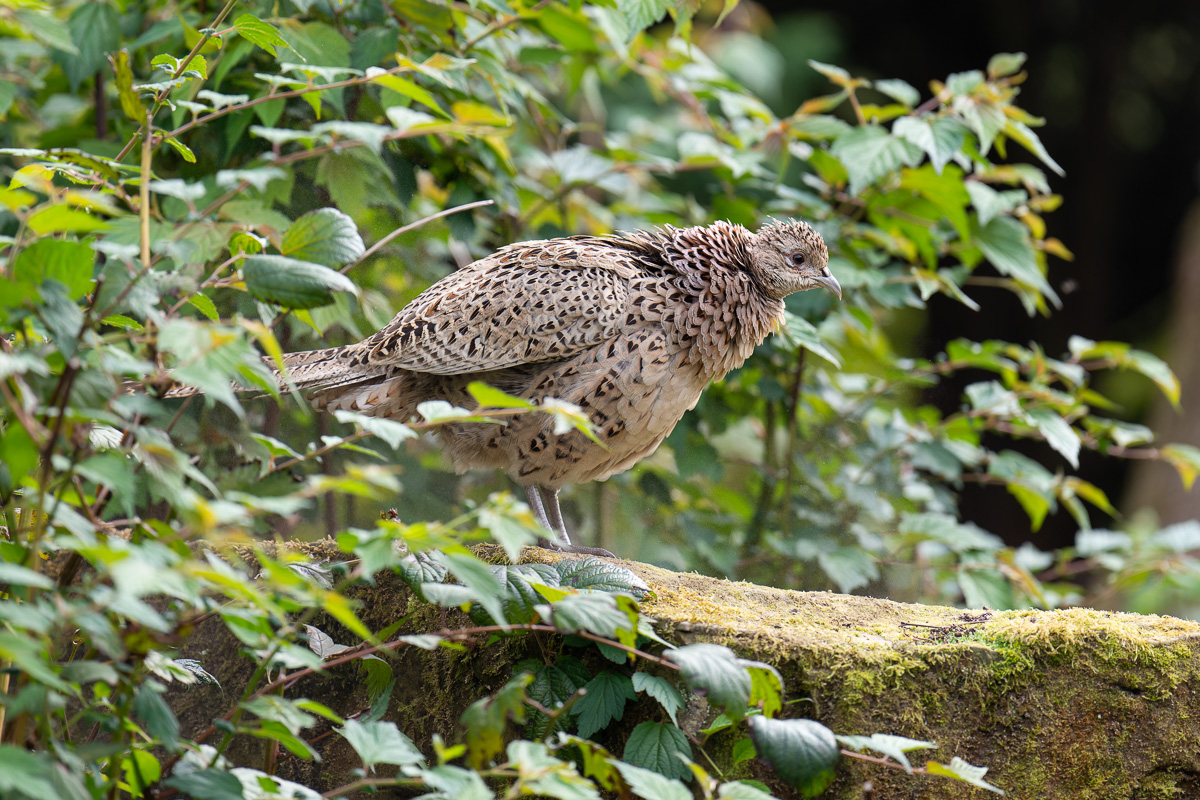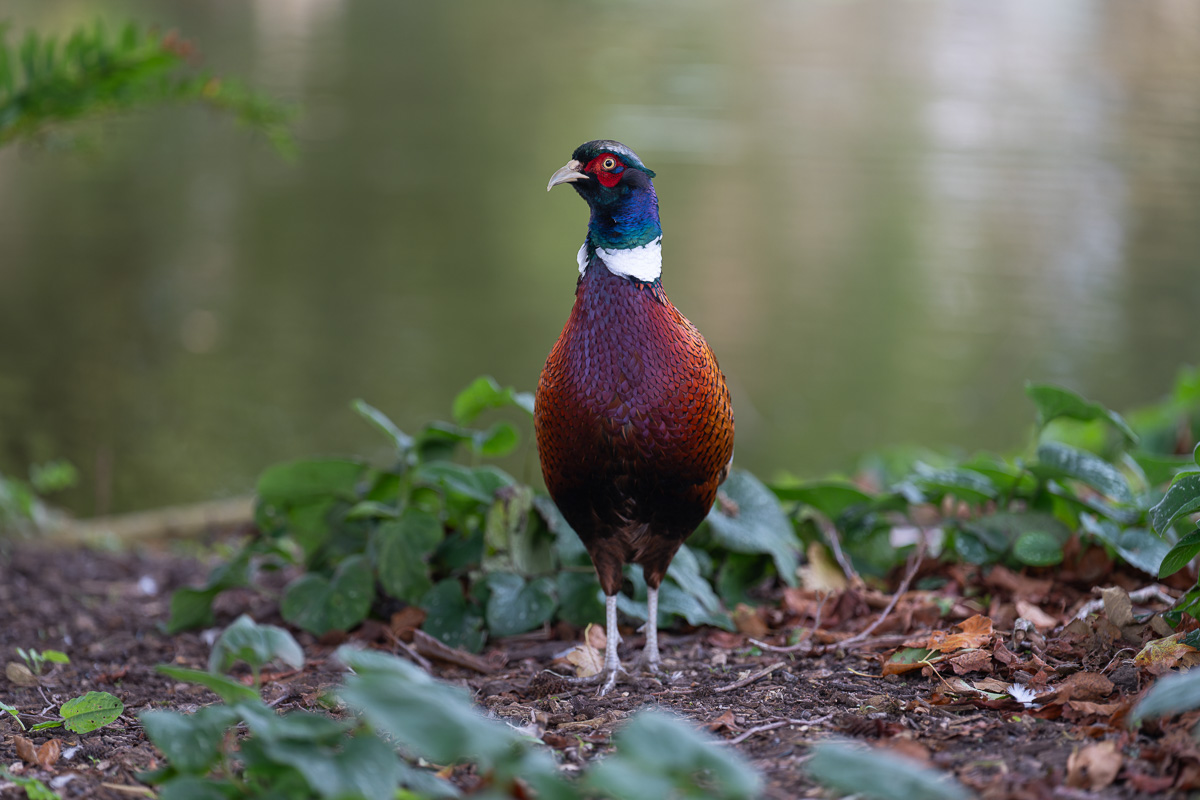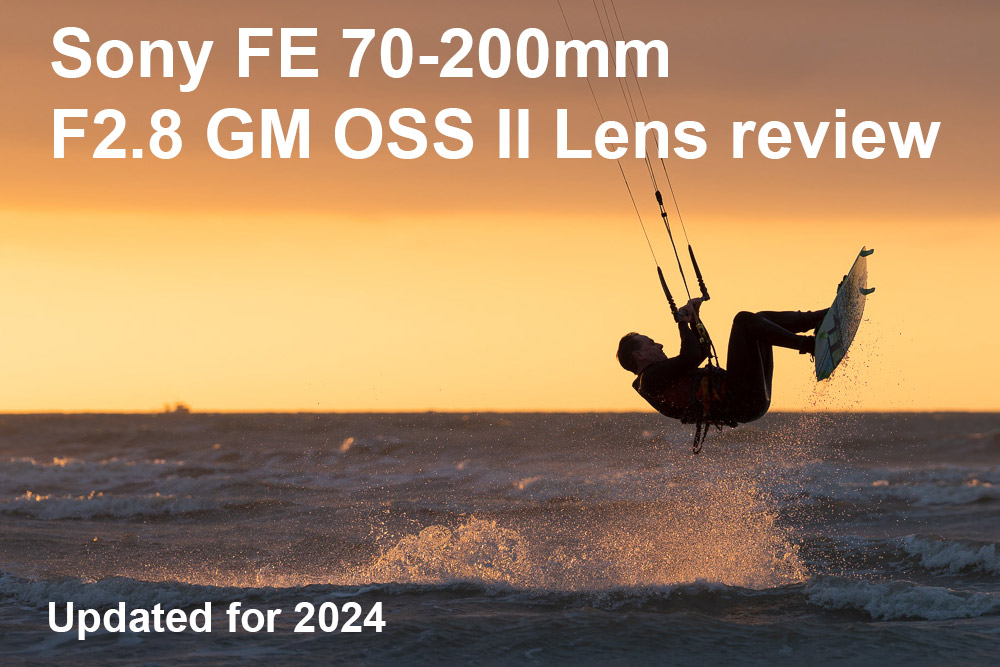- Call us: 01444 237070
- Contact Us
- Stores
- Sign In / Register
-
- Back
- Used Cameras
- Used Accessories
- Used Lenses
- Used Video
- Used Film Equipment
- Used Stock Alert
- Used Blank Test
- Sell or Part Exchange
- Used Clearance
- Recently Added Used Equipment
- Park Picks
- All Used Black Friday Deals
- Faulty
- Trade-In
- Blog
- New in
- Call us
- Contact us
- Stores
- Sign in
- Categories
- Tips & Inspiration
- Reviews
- News
- Events
- Features
- Buying Guides
- Competitions
Sony FE 70-200mm F2.8 GM OSS Mark II Lens Review
Kite surfer at 154mm. Camera settings: 1/1000sec. f/3.5. ISO 640 (cropped)
Sony FE 70-200mm F2.8 GM OSS II Lens review – updated for 2024
Whilst reviewing the Lowepro Pro Trekker BP 650 AW II Bag, I was fortunate to briefly experience shooting with the Sony FE 70-200mm f/2.8 GM OSS II. This second generation Sony mirrorless lens left such a lasting impression that we thought it would be a great idea to explore the lens further, in order to share real-world experiences. Our Sony FE 70-200mm F2.8 GM OSS II Lens review has been updated with new sample photos showcasing one of the most advanced telephoto zoom lenses available from Sony.
The included Sony 70-200 f2.8 ii sample photos have been updated to include image crops for you to establish just how sharp it is, right into the corners. We've got a video review by Gareth Evans for yet more hands-on experiences, in order for readers to gain a deeper insight into this workhorse holy trinity lens, which consistently delivers outstanding results across a variety of subjects.

Running dog at 182mm. Camera settings: 1/1000sec. f/2.8. ISO 1000.
Sony 70-200 f2.8 GM II Introduction
With a December 2021 release date, the Sony 70-200 f2.8 GM II holds the distinction of being the first mirrorless lens to receive a second-generation update. This is testament to its importance for photographers, especially as one of three holy trinity G Master lenses.
- ‘FE’ in the name means it’s designed for full frame Sony mirrorless cameras, although you can mount it on APS-C crop sensor bodies too, where the equivalent focal range becomes 105-300mm.
- It’s a telephoto lens with a bright, f/2.8 fixed aperture throughout the zoom range. This means it’s going to let in plenty of light at any of the focal distances and remains consistent throughout.
- It carries the prestigious GM label making it one of 14 current full frame G Master lenses. This series is designed for superior results and build quality aimed at professional users.
- OSS refers to Optical SteadyShot, which is Sony’s optical image stabilisation system.
- II refers of course to the updated mark II version for 2021, with the original mark I having been released in 2016.

Female pheasant at 200mm. Camera settings: 1/500sec. f/2.8. ISO 320 (cropped)
What does Holy Trinity lens mean?
Holy trinity refers to a trio of zoom lenses spanning a wide range of focal lengths, from ultra wide-angle to telephoto. In Sony’s case these include the Sony FE 16-35mm F/2.8 GM II, Sony FE 24-70mm F/2.8 GM II and the longest 70-200mm f/2.8 GM II.
All three offer essential zooms, allowing you to cover a range of subjects with each, alongside a wide f/2.8 constant aperture, and second generation versions offer a number of significant advantages over the original models.

Christmas table at 200mm. Camera settings: 1/250sec. f/2.8. ISO 4000.
Why did Sony update the 70-200mm GM II lens?
Sony updated the 70-200mm GM II lens to enhance its performance, particularly with the latest high-resolution cameras. Key improvements include reduced weight for better handling, faster and more precise autofocus, and upgraded optical design for sharper images, aligning it with the evolving needs of professional photographers.
There have been significant advancements in camera technology since the first generation was released back in 2016, and lenses need to keep pace. Sony now has camera sensors capable of resolving over 60 megapixels in the a7R IV a, A7R V and super-compact A7CR, which places higher demands on lens optics.

Kitesurfer pose at 80mm. Camera settings: 1/500sec. f/2.8. ISO 640.
Autofocus technology has also come on leaps and bounds, with AI driven subject detection and tracking, high speed shooting at burst rates of up to 30fps in the Sony A1 and even quicker in the groundbreaking Sony A9 III. Lens focus motors need to keep up with increasingly faster focusing demands of modern cameras.
Moreover, the trend in camera systems leans towards compactness and reduced weight, with an emphasis on lighter gear. This has resulted in the new zoom lens being nearly 30% lighter, a substantial reduction that eases the burden of excess weight.

Airborne kitesurfer at 200mm. Camera settings: 1/1000sec. f/3.5. ISO 1250.
What is a 70-200mm lens good for?
A 70-200mm lens is not confined to a single specialty – its 3x telephoto zoom range makes it exceptionally versatile, capable of covering a wide range of subjects effectively, including portraits, sports and wildlife photography. This enables you to capture more distant subjects with ease, and often without needing to crop.
The Sony 70 200 zoom range allows you to capture:
- Wildlife
- Bird photography
- Sports
- Action
- Portraits
- Fashion
- Weddings
- Landscapes
- Events
- Tele-macro
- Video

Bee detail at 200mm. Camera settings: 1/1000sec. f/2.8. ISO 500 (cropped)
The zoom range spans some critical focal widths such as 85mm, which is favoured for classic portraits, and also covers the many possibilities of a 135mm lens. What’s more you can add either of Sony’s teleconverters to increase the focal width by 40% when using the Sony 1.4x Teleconverter, or 100% with the Sony FE 2.0x Teleconverter, providing 98-280mm and 140-400mm respectively.

Endless harbour details at 200mm. Camera settings: 1/125sec. f/2.8. ISO 125.
What is updated for the 70-200mm f/2.8 mark II lens?
Sony completely redesigned the second generation 70-200 lens, addressing virtually feature in order to cater for contemporary professional needs. Some of the most important updates are answered below:
- How much does Sony 70-200 GM weigh compared to GM II? At 1045g, the new lens is 435g or 30% lighter than the original, which weighs 1480g.
- What is the sharpest aperture on Sony 70-200 GM II? A new optical design helps the lens to maintain sharpness even when shooting wide open at f/2.8. According to MTF charts, sharpness increases very slightly at f/3.2 and f/4, however almost anyone would be extremely happy with results at f/2.8. Corner sharpness has been notably improved in the new model, which will appeal to creators who need edge-to-edge sharpness for a variety of subjects.
- What is the minimum focus distance for 70 200 gm II? The minimum focus distance is 0.4m at 70mm (wide), and 0.82m at 200mm (tele). The maximum magnification is 0.3x, which is excellent, although not quite as high as the updated Sony FE 70-200mm F/4 G OSS II Lens, which doubles as a macro lens.
- Is the Sony 70 200 f2 8 GM II faster focusing? Yes, the Sony 70-200 f2.8 GM II lens boasts significantly improved AF speed, largely due to its four XD (extreme dynamic) focus motors. While the original model was no slouch, the new version enhances AF performance significantly, with speeds up to four times quicker. This is achieved by using two motors for each focus group, ensuring rapid and efficient focusing. Users can expect a noticeably enhanced experience, particularly in terms of autofocus speed and precision.
- Focus tracking while zooming is around 30% quicker compared to the original. This means your hit rate is going to go up considerably if you track moving subjects.
- The Sony 70-200 f2.8 GM II lens features enhanced manual focus control, thanks to its updated Linear Response MF and the option for full-time Direct Manual Focus. This is particularly beneficial for those who sometimes rely on manual focusing adjustments, and for video recording. It's especially useful for capturing subjects obscured by obstacles, such as wildlife hidden behind foliage or sporting events happening behind spectators, offering more precise control during challenging situations for camera AF.
- For videographers, the lens brings several improvements, including reduced focus breathing, enhancing the quality of video capture during focus pulls. The inclusion of an iris lock switch and an aperture click switch also add greater control and flexibility for filmmakers.
- The mark II lens now includes a third option in its stabilisation control, specifically designed for rapidly moving, erratic subjects. This setting is ideal for scenarios where the subject's movement is unpredictable, requiring the Optical SteadyShot (OSS) to constantly adjust.
- Sony incorporated their latest mark II Nano AR coating, which helps to control flare and ghosting in backlit situations.

Male pheasant bird at 167mm. Camera settings: 1/250sec. f/2.8. ISO 320.
It’s safe to say that the new generation surpasses the original in virtually every respect, which is outlined in the specs table below.
Sony FE 70-200mm f/2.8 GM I VS II specs comparison
|
|
||
|
Lens Elements/Groups |
23/18 |
17/14 |
|
Special Elements |
4 ED glass elements 2 Super ED glass elements 3 aspherical elements (including one XA) |
2 ED glass elements 2 Super ED glass elements 2 aspherical elements (including one XA) 1 ED Aspherical element |
|
Focus Mechanism |
Two focus motors (RDSSM and double linear motor actuator) |
Four XD (Extreme Dynamic) Linear Motors |
|
Lens Coating |
Nano AR Coating |
Nano AR Coating II, Fluorine |
|
Lens controls |
Focusing ring Zooming ring Focus mode switch Focus range limiter Focus hold button Shake compensation switch Shake compensation mode switch |
Focusing ring Zooming ring Focus mode switch Focus range limiter Focus hold button Shake compensation mode switch with 3 options Linear response for MF Aperture ring Aperture click switch Iris lock switch Direct Manual Focus switch |
|
Minimum Aperture |
f/22 |
f/22 |
|
Aperture Blades |
11 |
11 |
|
Circular Aperture |
Yes |
Yes |
|
Minimum Focus Distance |
0.96m |
0.4m |
|
Maximum Magnification Ratio (X) |
0.25x |
0.3x |
|
Filter Diameter |
77 mm |
77 mm |
|
Image Stabilisation |
Yes |
Yes, with new third mode |
|
Teleconverter Compatibility |
Yes |
Yes |
|
Weather Sealed |
Yes |
Yes |
|
Dimensions (D X L) |
88 x 200 mm |
88 x 200 mm |
|
Weight |
1480 g (without tripod mount) |
1045 g (without tripod mount) |
|
RRP |
£2,500.00 |
£2,600 |
Landscape photo at 100mm. Camera settings: 1/13sec. f/8. ISO 100 (tripod mounted).
Video Review
Build and handling
The Sony 70-200 f2.8 GM II is the same size as its predecessor, with slight repositioning of the rings for ease of use, ensuring a seamless transition for anyone upgrading. It also keeps the same popular 77mm size for lens filters as its predecessor, allowing the use of any existing filters you may have.
During everyday use, the Sony 70-200 f2.8 GM II’s reduced weight makes it perfect for handheld shooting. Lighter build facilitates quick compositional changes and allows for easy repositioning as the subject moves, adding to its proficiency in varied shooting situations. Overall, the weight reduction is a major advantage, offering a lighter feel that enhances handling and portability, even when compared to the FE 100-400mm F/4.5-5.6 GM OSS, which feels considerably more substantial in the hand.

Autumn leaves at 100mm. Camera settings: 1/13sec. f/8. ISO 100 (tripod mounted, focus stacked)
As one of Sony's esteemed G Master series, the 70-200 f2.8 GM II lens boasts extensive weather sealing and high-quality build. Despite being so lightweight, it feels solid and not at all plasticky, with a durable feel in the hand.
The control layout is similar to the original, but with additional options added to the Mark II. This allows photographers to work at their usual pace with less fatigue and faster results, thanks to its lighter weight and enhanced features.
Having Direct manual focus (DMF) is a distinct advantage in situations where the subject is not found by the camera. This can happen for a variety of reasons at any time, especially when first acquiring a subject. By manually pre-focusing near your subject and then allowing the camera's autofocus (AF) to take over, you can save time and often capture shots that might otherwise be missed. This technique blends manual and automatic focusing to quickly adjust to fast-moving or unpredictable subjects, and to punch in beyond obstacles, enhancing your chances of getting the perfect shot across numerous situations.

River boats at 100mm. Camera settings: 1/500sec. f/2.8. ISO 200
Sony 70 200 f2.8 GM II AF speed
A key advantage to the second gen. lens is its autofocus capability, which is impressively quick. The lens kept pace with every subject I chose to shoot, regardless of focal length or closeness to the minimum focus distance, for tele-macro shots of bees, more distant birds, sports and action.
The quad linear XD motor design has subsequently been used across several G Master lenses such as the other updated Holy Trinity lenses, and the FE 50mm F/1.2 GM, due to its proficiency for near instantaneous subject acquisition. The telephoto lens also includes a 3m range limiter to reduce time spent hunting across the entire focus range, but focusing from near to far is still incredibly fast, making it a dream to use for suitable subjects.

Buttery smooth defocus at 200mm. Camera settings: 1/200sec. f/2.8. ISO 4000
Summary
Sony has a comprehensive range of telephoto zoom lenses for Alpha mirrorless cameras, from the 200-600mm super telephoto to this workhorse 70-200mm. The Sony 70-200mm GM II lens's wide appeal stems from its versatile zoom range, making it a premium choice for a variety of genres. It is well-suited for everything from close-ups to sports, especially with the option to add a teleconverter for extended reach. The constant bright aperture caters to demanding professional needs, excelling in low light and handheld shooting conditions, as well as for separating the subject from silky smooth backgrounds.
The zoom lens maintains the same size as the original, but brings significant enhancements including being sharper in the corners, it’s considerably faster, and much lighter. The inclusion of four XD linear motors drastically improves autofocus performance, ensuring a higher keeper rate even with fast-moving subjects.

Bokeh test at 88mm. Camera settings: 1/250sec. f/2.8. ISO 1000.
It's optimised to work with the latest camera AF systems for tracking faces, eyes, animals, birds and other subjects. While it lacks an Arca Swiss type foot (my only gripe), the overall improvements make it an upgrade that warrants serious consideration, especially for those who need the fastest zoom possible.
Photographers who want the best optics possible will be drawn to the mark II 70-200mm for its fantastic results, and we can’t wait to see what you do with it. Reserve your Sony FE 70-200mm f/2.8 GM OSS II today to experience just how this incredibly versatile lens can transform your photography.
All of the 70-200 GM II sample photos were taken by Nick Dautlich using the Sony A7R V, which boasts a 60 megapixel sensor, dedicated AI focusing unit and 10fps RAW burst shooting with AF/AE tracking.
Share this post:
By Nick Dautlich on 27/12/2023
Nick Dautlich
Senior Content Writer and Product Reviewer
Nick Dautlich is the Senior Content Writer and Product Reviewer at Park Cameras, with over 15 years of photography experience. A Sony Imaging Professional and expert reviewer, Nick has worked with major brands such as Canon, Sony and Nikon. His work is also featured on Vanguard World UK’s website, Capture Landscapes, and Shutter Evolve. Nick’s photography includes National Trust projects and magazine covers and he is passionate about landscapes and storytelling. Nick also enjoys hiking and teaching his children about nature. Learn more on his profile page.

Trade in your old equipment
Fast and easy trade in service ensures your old gear is collected efficiently and you are paid quickly! It's very simple to trade in your unwanted photography gear. Just head over to our dedicated Sell or Part Exchange page, fill out the details, and we'll get back to you with an offer for your old gear. Take the cash, or put it towards the cost of your new gear. It's up to you! Find out more
sign up to the newsletter
Keep up to date on the latest photography news, events and offers. Sign up now


